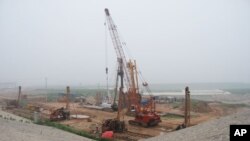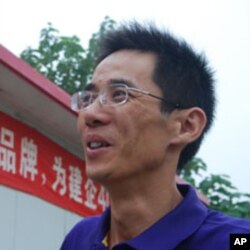A 50-year plan to divert water from the Yangtze River to China's dry, thirsty north has run into problems. The South-North Water Transfer Project is behind schedule and now concerns are growing the water to be pumped north is contaminated.
Regiments of pile drivers pound the earth at the giant Daning Reservoir on the southern outskirts of Beijing. The huge excavation is part of the most ambitious plumbing job in the world - and the oldest.
China's South-North Water Transfer Project was first planned 50 years ago, but work began in earnest in 2004.
On completion, the $60 billion project will divert water from the mighty Yangtze River Basin more than a thousand kilometers south to northern China.
One of the many engineers on the Daning site is a man who identified himself only as Peng.
Engineer Peng says the reservoir should be completed by early next year if all goes according to plan.
Water is being diverted southward in three giant channels, eastern, central and western.
Daning reservoir is the end of the line for the central channel.
Like the building of the Yangtze Dam, millions of people have been relocated by the government in what has been described as a sacrifice to solve the nation's drought problem.
But China's biggest hydro-engineering project is in deep trouble.
It is far behind schedule, thus worsening the water crisis in large northern cities like Beijing, where the population is rapidly growing.
Worse, recent reports say the water from the basin is so contaminated that even the 400 expensive treatment parts along the route cannot make it safe for use.
Wang Jian Hua is a scientist from Institute of Water Resources and Hydropower Research who had agreed to talk about the project. He says he can no longer comment about the South North Water Transfer Project as right now it has become what he describes as a sensitive issue.
VOA asked to speak to other government departments about the project but all refused to comment.
Demand for water has never been so high in China.
Three-hundred million people are moving from the country side to the cities. Statistics indicate these re-located farmers use three times the amount of water in the cities compared to farming the land.
There is also 30 years of environmental damage from the fast pace of modernization. Water tables, the 'surface' of the ground water in a given vicinity, are heavily polluted from unchecked industrialization. This puts enormous pressure on policy makers in the world's most populous country to come up with solutions to the water shortage.
The question now is whether engineering feats such as the South North Water Transfer Project will work. British journalist Jonathan Watts has just published a book on China's environment issues titled "When a Billion Chinese Jump." He has visited several sites of the South North Water Transfer Project.
"On the question of whether it works, obviously the Chinese government has gambled a great deal on the assumption that it will work," he said. "However, we're a considerable part of the way through the project and some problems have emerged that do raise serious questions for the engineers."
Among those problems, Watts says, is the severe drought that struck southern China earlier this year. He says this raises questions as to whether the south really has enough water to help out people in the north.
Water has become not only a precious commodity in China. It is fast becoming a defining social and political issue.
At Daning Reservoir, the pile drivers spark once more to life after a short lunch break. Workmen pour concrete into huge trenches near six huge metal sluice gates.
Engineer Peng says the current focus of work is on the grounds of the reservoir. He has to ensure the precious cargo soon to be delivered far from the south does not leak and waste away.









